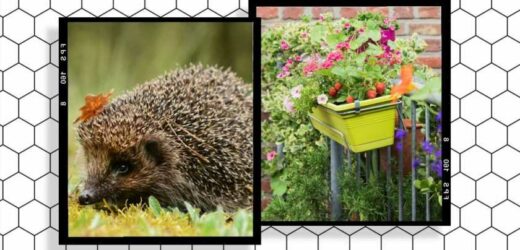Written by Alex Sims
Some of the UK’s most loved species are currently on the brink of extinction. Help them survive by turning your home (and your kitchen) into a wildlife haven with these expert tips from Autumnwatch presenter Megan McCubbin.
Spending just 10 minutes surrounded by the natural world can reduce our stress levels, so it’s no surprise we’ve become more grateful than ever for the nature around us over the last 18 months. But, Britain’s natural landscape is at risk of changing beyond recognition with many of our best-loved species tottering on the precipice of extinction.
From bats and hedgehogs to butterflies and bumblebees, many precious native species have been added to a list of creatures at risk of vanishing from the country forever if nothing is done to protect them.
The ARC 2031 study, developed by Go Organic and the Horniman Museum’s principal curator of natural sciences, Jo Hatton, lists 10 creatures most at risk of extinction due to the industrialisation of food production and the excessive use of harmful pesticides.
Released to mark Organic September, a month-long celebration highlighting the benefits of organic food for biodiversity, the list includes creatures such as the grey partridge, the grey long-eared bat, the hedgehog and the garden bumblebee.
“Wildlife is in dire trouble,” Arc 2031 ambassador, zoologist and Autumnwatch presenter Megan McCubbin tells Stylist. “Britain is one of the most nature-depleted countries in Europe; we have nowhere near as much wildlife as we should because of habitat loss, fragmentation and intensive farming.
“Species are facing an increased background rate of extinction because of human activity. On average, species are dying out somewhere between 10 and 100 times faster than the natural baseline extinction rate due to human influence. It’s become more important than ever that we refocus and make a change.”
Here, McCubbin highlights four things we can all do to make our homes more wildlife-friendly and help protect these endangered native species, whether you live in a house with a garden or a top-floor flat.
Start buying organic food
If you don’t have a garden, you can still support UK wildlife by changing up some of your usual shopping habits. “One of the major things driving climate change is food production,” says McCubbin. “It’s responsible for as much as 40% of worldwide carbon emissions.”
Buying organic food, or swapping some of the products in your regular shop for organic versions, can have a huge impact. Organic farming ditches harsh chemicals and pesticides for natural methods that create and maintain healthy soils and support wildlife. As a result, organic farms are, on average, home to up to 50% more wildlife and 30% more species.
“The food we buy has a huge effect on our environment and the biodiversity within it, but we don’t often connect those dots,” says McCubbin. “Organic farms are refuges for creatures like the hedgehog and birds like corn bunting, which feed on insects that organic farms protect by abandoning pesticides. We can actively encourage these species by buying from farms that protect food chains and don’t wipe out insects these animals feed on.”
“It doesn’t have to be expensive,” McCubbin adds. “Do some research into the price points at different retailers. Sometimes a supermarket’s own-brand organic products can be cheaper than alternatives from other brands. It’s about investigating and just making little switches here and there.”
What to look for when you’re buying organic products
When you’re looking for organic products, be vigilant about the certification logo on the foods. If foods have this logo it means the product meets the strict requirements demanded by organic standards.
Any farms or brand that labels their products as organic must be registered with an approved, independent control body, such as Soil Association Certification or Organic Farmers & Growers. This means they will undergo regular inspections to ensure that they meet the organic standards.
There are a few different certifiers in the UK, and each has its own certifying logo. You can find a list of the specific logos on Go Organic’s website.
Grow your own
If you want to take your organic aspirations to the next level, McCubbin suggests growing your own food at home. “It doesn’t matter if you have a garden or a window, there is always something you can do in your immediate environment to benefit wildlife,” she says. “It doesn’t get better than growing something yourself. Then you’re really connected to what goes into the food you eat.”
If you don’t have a garden, you can grow produce in containers on a balcony or patio. Vegetables like beetroot, mixed leaves, spring onions, radishes, chicory, courgettes and tomatoes grow well in pots. Start the process by planting the vegetables in organic compost in seed trays. When they outgrow the trays, move them to a bigger container at least 40cm deep so there is room for the roots to grow. Use an organic fertiliser so the plants get the same minerals as if they were growing in the ground.
If you only have a window sill, this is a perfect place to grow herbs. McCubbin, who lives in a city flat, grows basil plants on her window sill.
Plant wildflowers
“Native wildflowers are really important because they’ve evolved with our insects, which makes them compatible with one another and encourages native biodiversity,” says McCubbin.
Data from the ACR 2031 suggests that four in 10 of the country’s 1 million insect species are at risk of dying out, which has dire consequences for the creatures that feed on them. So, growing native flowers at home is one of the best things you can do to protect endangered species.
“People talk about growing native flower meadows and that’s wonderful if you have the space to do it, but if you have limited outside space you could also plant a wildflower strip or have wildflower pots. Every little helps,” says McCubbin.
McCubbin has her own wildflower pot in her city flat: “There aren’t many other flowers where I live, so my little pot is a gem of pollen for insects flying by.”
Help hedgehogs
The spiny, nocturnal, lactose-intolerant creatures are one of our most beloved animals. But, despite seeming like a stalwart of the country’s parks and gardens, hedgehog numbers have fallen up to 30% in urban areas and 50% in rural areas since the millennium, according to the State of Britain’s Hedgehogs report.
If you have a garden you can optimise them for the prickly creatures by creating ‘hedgehog highways’, aka carving out holes around the size of a CD case in the bottom of your fence. “This lets the hedgehogs move easily from garden to garden, which is really important so they can find resources and mates,” says McCubbin.
Creating a space for a hedgehog house in your garden also gives the animals a secure habitat where they can rest and hibernate away from predators. But, it’s important to buy the correct type. “Make sure the hedgehog house you buy has a curved entrance and its own chamber to stop paws from being able to get in,” says McCubbin. “Even an upturned bucket full of straw will work.”
As bonfire season approaches it’s also important to check if anything is living in any big piles of leaves that have accumulated in your garden before you burn it. “A big pile of leaves is ideal for a hedgehog to hibernate in and a lot of hedgehog hospitals get inundated with scorched hedgehogs around bonfire season, so always double-check.”
Leaving out wet cat food and a shallow bowl of water is also a way to care for hedgehogs as their habitats and food sources decline.
The Organic September campaign runs until the end of the month. Find out more on the Go Organic website.
Images: Getty, Go Organic, schnuddel, Piotr Krzeslak
Source: Read Full Article






